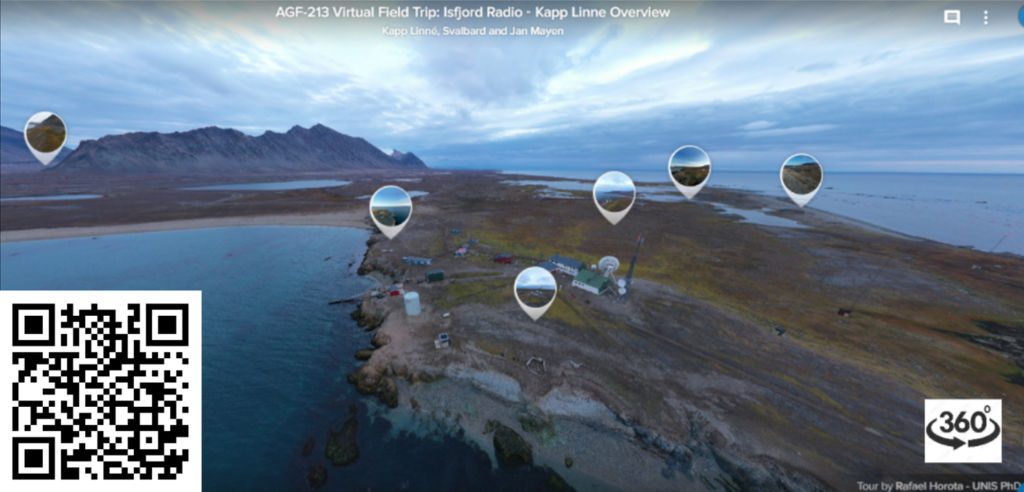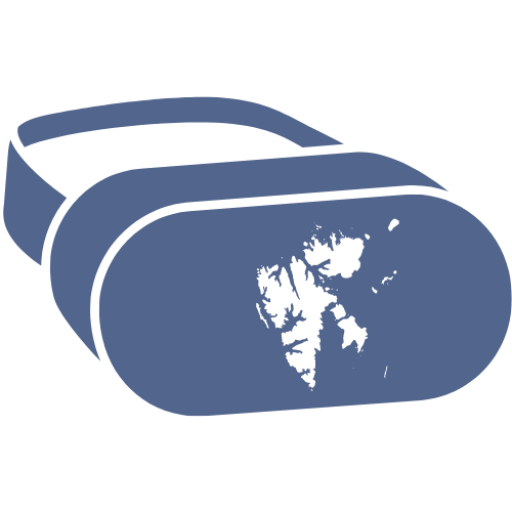1. The project
This project have two main objectives: 1) to generate web-based Virtual Field Guide (VFG) teaching materials for key geoscience field learning locations in Svalbard and 2) to teach iEarth partners on the mainland how they can generate VFG for their own field trip locations or on how use the ones from Svalbard in their own teaching. The generated learning material will provide students access to virtually familiarize themselves with Svalbard’s unique field environments and as pre- and/or post- physical field trip exercises. We hypothesize that this extended access to field sites before and after field work can improve students’ field learning processes. The generated material will also provide the basis for a thorough evaluation on whether VFGs can contribute to enhance students’ field learning outcomes in Rafael Horota’s Ph.D. thesis.
The VFGs generated under objective 1 will be build over the prototype VFG that was developed for the Isfjord Radio area in Kapp Linné – Svalbard as part of the iEarth FROST Project in autumn, 2021.

2. Aims and relevance for the iEarth vision and progress domains
The aim of There and Back Again: Svalbard and Beyond Edition is to generate a teaching resource (Virtual Field Guide) that will enhance the accessibility of field trip localities. The project is a step forward into making Svalbard and the mainland’s unique environments accessible for everyone.
The generated teaching materials (VFGs) will be directly used in the UNIS Arctic Geology bachelor courses: AG-209/AG-222 (“The Tectonic and Sedimentary History of Svalbard” and “Integrated Geological Methods”) that run annually from January to June, typically visiting the Festningen locality on Western Spitsbergen and the Billefjorden Trough in Central Spitsbergen; AG-210 (“The Quaternary and Glacial Geology of Svalbard”) annual course that runs from August to November, typically visiting Aldegondabreen by Grønfjorden ; AG-204/AG-221 (“The Physical Geography of Svalbard and Arctic Physical Geography Field Techniques”) annual course that runs from August to December, typically visiting Bogerbreen, Larsbreen, Longyearbreen, Tunabreen, and Von Postbreen; and AGF-213 (“Polar Meteorology and Climate”) an annual course that runs from August to December, typically visiting Isfjord Radio, Kapp Linné.
The students of these courses are frequently exposed to uncertainties connected to arctic weather during their fieldwork, which together with, for example challenging snow conditions, polar bears and limited daylight might significantly shorten their field experiences and learning outcomes from the course. The There and back again: Svalbard and Beyond Edition project will thus provide enhanced learning experiences for the students, that for some reason might see themselves impaired by these issues by virtually deliver field data and exercises they otherwise would not have access to.
This project is relevant across the iEarth domains, especially for Focus Area 4 (FA4), where the main objective is to test and document methods to enhance connection and knowledge transfer between classroom and field learning. It will also nicely align with the FA4 assessment criteria of implementing digital teaching tools such as Virtual field guides, and digital field tools in >2 courses at each of the iEarth partner institutes. The project also aligns with FA3 in that we will engage students as participants and partners in the project by developing the VFGs in collaboration with them during fieldwork where they take part in addition to have them evaluate the end-products through among other questionnaires.
3. The project plan, milestones, allocation of responsibilities and resources
The There and Back Again: Svalbard and Beyond Edition project will ideally start on 15.02.2022 and run until 30.1.2023, when the VFGs will be launched as part of the aforementioned courses at UNIS. The start date is related to the ca 6 weeks processing time for the application and to the start of the spring field season.
All the following course responsible at UNIS: Kim Senger, Aleksandra Smyrak-Sikora, Andy Hodson, Mark Furze, Aga Nowak, Marius Jonassen, Mike Retelle, and at UiB: Christian Eide, have especial interest in this project and they will be involved on the development of their courses VFGs, providing guidelines on how they intend to use them and the necessary information for the virtual experiences. We also expect to get the support from course responsible from other iEarth partner institutions to work in collaboration to implement and evaluate the tool in their home university courses. To facilitate this connection iEarth educational chairs (Bjarte Hannisdal UiB, Karianne Lilleøren UiO, Anders Schomacker UiT, and Mark Furze UNIS) will help on organizing the workshops and in making sure we are reaching the right people.
All imagery data (drone 360° panoramic photographs) will be acquired while participating in each of the courses field trips to be run 2022. The There and Back Again: Svalbard and Beyond Edition project will hire a student to work closely with courses responsible to integrate all data, and put these into a comprehensive digital format to be shared on the Svalbox.no platform or other web page. The project will pay the salary for the student, and travel expenses for workshops in mainland partner institutions.
4. Plan for evaluation, dissemination, and reporting
We will evaluate each VFG version developed in coordination with the course responsible of each course and collect feedback on user experience and relevance of the tool with participant students. The students will also evaluate the VFGs using an online questionnaire. The teaching material will be available for use for anyone, and to maximize its impact we will highlight it through a brief introduction video (to be shared on iEarth.no, UNIS.no, Svalbox.no, etc.). In addition, we plan to present the best evaluated VFG at a SoTL conference in 2023 (expenses associated with this will be covered from other sources) and write a scientific paper as one of the papers of Rafael Horota Ph.D. Thesis.
5. Transfer value to other teachers
This project results and recommendations will be shared as a report that will be made available on this platform. It will discriminate all the necessary information needed to build other VFG in a workflow.
Courses responsible from the mainland will benefit from this material and will be able to develop VFGs for their own courses. We hope this changes the teaching cultures in place-based education and complements already existing field activities. VFGs and associated teaching material will be shared within the iEarth network but also advertised through UNIS’ central networks including the University of Arctic (where Kim Senger leads the Arctic Geology thematic network) and APECS.
